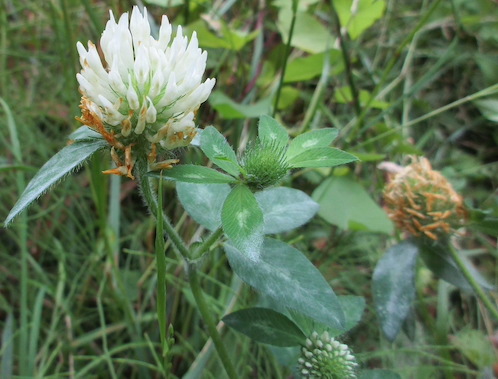
|

|
| Red Clover; Trifolium pratense L. |
Pea Family; LEGUMINOSÆ (FABACEÆ)
|
| Red Clover is a perennial herb of strong, enduring constitution. It is a familiar inhabitant of meadows, fields, infrequently-mown
lawns, and disturbed sites. Not fussy as to soil quality, it asks only adequate sunshine. It grows about a foot tall and spreads wider.
Remarkably long-stemmed leaves are tri-lobed and usually attractively marked with a characteristic mottled blotch. Although other clovers
are sometimes found four-leaved, Red Clover almost never is. Other names are: Purple Clover, Honeysuckle (Trefoil), and Sugar Plums. |
| As with many plants, Red Clover is at its best in May and June, when its deep roots send forth all their stored energy for its full
bloom and vigor. The dense pink flower heads are honey-rich "sugar plums." Unfortunately, they wither to an unsightly brown color
after pollination. Only once in my life have I found a white-flowered Red Clover. |
| Native in the Old World, Red Clover was early introduced to North America in 1747 because of its great value. Although we can
call it a weed in cities, it is only a very minor one, and compared to
some clovers is not one at all. It has been extensively used in
agriculture for pasturage, hay, as a honey plant, and as a cover-crop and green manure to improve the soil. Different strains (called cultivars)
are available commercially for specific purposes. |
| Vermont chose Red Clover as its State Flower, and it happily signifies "industry" in the Language of Flowers. Herbalists have
found in it some mild medicinal value (e.g., alterative, antispasmodic, diuretic and expectorant properties). An alcoholic extract contains
the isoflavone genistein, useful in treating cancer. |
We would welcome the plant in our urban gardens if it did not tend to become so ratty-looking by late summer. But all too often
it is dusted with powdery mildew, or is insect-chewed, or simply looks pitiful for no particular reason. However, salad lovers should
not neglect to add its delightful flowers and tender, rank growth to their list of ingredients. Though chewy and strong (even harsh)
flavored, this cousin of alfalfa surely contains a goodly share of nitrogen, protein and other necessary nutrients. Incidentally, the same applies to
other clovers as well; some such as Alsike (T.
hybridum) and White (T. repens) Clovers make even better eating.
|
Originally published as the Seattle Tilth newsletter Weed of the Month in December 1988, along with an illustration drawn by Annie Figliola.
Back |
|
|

